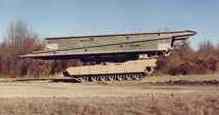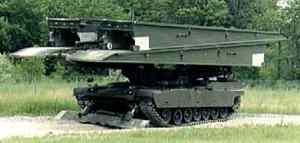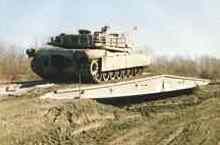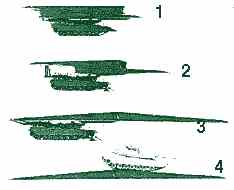| Designation: | M1074 JABS Wolverine |
 |
|---|---|---|
| Manufacturer: | General Dynamics Land Systems - GDLS | |
| Product type: | Armoured Vehicles | |
| Name: | Armoured vehicle-launched bridge |
The Fiscal Year 2001 Army budget request included decisions to restructure or "divest" a number of programs in order to provide some of the resources to support its transformation to achieve the ambitious deployment goals outlined in the October 1999 Army Vision. The restructured programs are the Crusader and the Future Scout and Cavalry System. The "divestitures" include Heliborne Prophet (Air), MLRS Smart Tactical Rocket (MSTAR), Stinger Block II, Command and Control Vehicle (C2V), Grizzly, Wolverine, and the Army Tactical Missile System Block IIA. Funding for these programs was reallocated to fund the Army Vision transformation strategy.
The Wolverine (Formerly the Heavy Assault Bridge) is an armored vehicle designed to carry, emplace, and retrieve an assault bridge capable of supporting 70 ton loads such as the M1A2 main battle tank. The Wolverine is a combat support system which integrates advanced bridging, hydraulic and electronic control capabilities into a single survivable system. Wolverine fills the need for a combat gap crossing capability with the same mobility, survivability, and transportability as the M1 Abrams tank. WOLVERINE is to be a one for one replacement for the Armored Vehicle Launched Bridge (AVLB) in select heavy divisional engineer battalions, armored cavalry regiments and heavy separate brigades.
The WOLVERINE consists of an M1 Abrams tank chassis modified to transport, launch and retrieve a Military Load Class (MLC) 70 bridge across gaps up to 24 meters wide. WOLVERINE will be air-transportable in the C-5A aircraft and will be comparable in mobility and survivability to the Abrams tank. A crew of two MOS 12B will operate the system. WOLVERINE will provide the Army's Digital Division with mobility support (i.e. assault bridging) for Decisive Operations IAW Army Vision 2010.
The WOLVERINE provides the dominant maneuver force with the capability to span gaps up to 24 meters (m) with little or no loss in momentum. The bridge, made of four interchangeable sections, is 26 m long, 4 m wide, weighs 10,886 kg (12 tons), and is required to permit crossing of a heavy task force consisting of Military Load Class (MLC) 70 vehicles moving at 16 km/hr. The hull will be based on the future M1A2 System Enhancement Package (SEP) chassis modified to support a two-man crew and the bridge launcher assembly. The crew can launch the bridge while under armor protection from either crew position in five minutes after reaching the crossing site and can retrieve it from either end in ten minutes. The WOLVERINE will retain significant compatibility with the M1A2 fleet. The dominant maneuver force will support the WOLVERINE's bridging operations with ongoing direct and indirect fire and air support. The WOLVERINE will directly replace the existing Armored Vehicle Launched Bridge in selected engineer companies of mechanized battalions, armored cavalry regiments, and heavy brigades.
The WOLVERINE is employed as an integral part of the M1A2 SEP/M2A3 equipped digital maneuver battalion task force. WOLVERINE as part of the Breach Force and supported by friendly direct and indirect fires, will provide a 24 meter one way gap crossing capability for MLC 70 normal crossing loads with minimal preparation and with little or no loss of task force momentum. The bridge structure will be durable enough to withstand 5000 crossings of 70-ton vehicles and be launched and retrieved at least 2200 times without major repair.
The Wolverine is an Acquisition Category II program that began in 1983. A foreign comparative test was conducted in 1989, and an October 1990 Milestone I/II decision moved the program into the Engineering and Manufacturing phase. In December 1990, the program was canceled due to a reduction in Research and Development (R&D) funding. In December 1991, the Wolverine program was reinstated and identified as a Desert Storm initiative. Funding was obtained for a two-phased EMD, which included a comparative test between three bridges: "Christchurch No. 10 Bridge", built by SMS and Thompson Def Projects; the "Leguan," which was built by General Dynamics[Image] Land Systems (GDLS) and MAN/GHH; and the "Double Fold Scissors Bridge," built by BMY and IMI.
In 1994, a contract was awarded to GDLS, which initiated the second phase of EMD, to integrate the Bridge and Launcher with the M1A1 Abrams chassis and produce two prototype Wolverines for limited developmental and operational testing. In January 1996, a decision was made to migrate the M1A1 chassis to the M1A2 System Enhancement Package (SEP). The decision to upgrade to the SEP configuration was based on the need for achieving greater commonality with the Abrams upgrade efforts through the use of common hardware and manufacturing processes to reduce production, operation, and support costs. In August 1996, a base vehicle contract was awarded for two vehicles with an option in December 1996, for an additional four pilot vehicles.
Following a significant increase in the WOLVERINE program's procurement objective to the currently planned 465 units, the Army's Acquisition Executive in a memorandum dated June 4, 1996, notified OSD that the Army designated the WOLVERINE an ACAT II program and a covered system for LFT&E. The program was added to the T&E oversight list in December 1996 for LFT&E only. This system is not an operational test and evaluation oversight program. MSII for the WOLVERINE program, which occurred in June 1992, predated the assignment of the system to the oversight list. DOT&E participated in the WOLVERINE LFT&E Integrated Process Team (IPT) beginning in May 1996 and approved the completed LFT&E strategy in March 1997. Dedicated LFT events began in 4QFY97 and extended through 3QFY99.
The approved LFT&E strategy includes three phases of testing: ballistic testing against a deployed bridge; full-up, system-level testing against a production representative launcher mounted atop a prototype chassis; full-up system-level testing against a production representative system. The LFT&E IPT completed the LFT&E strategy development and finalized test and evaluation plans for, and executed the first phase of, the LFT&E program. Test objectives satisfied during this test phase included data collection and assessment of the ballistic response of the bridge and its constituent materials, calibration of structural models supporting evaluations of the capabilities of damaged bridges, and the investigation of Battle Damage Assessment and Repair techniques with the assistance of soldiers from the Ordnance Center and School.
DOT&E approved the test design and evaluation plans for the second phase of the LFT&E program in November 1997. The second phase will employ full-up system-level tests of a production-representative bridge launcher on a prototype Wolverine chassis. The LFT&E program will culminate in a third phase with full-up system-level tests of a production-representative Wolverine system.
During Phase I testing, bridge elements were subjected to over 30 events including attack from small arms, mortars, a mine, an artillery shell, and an anti-tank guided missile. To support a realistic system vulnerability evaluation, the threats and test conditions encompassed the system requirements and explored the response of the bridge to more severe threats that could be encountered on the battlefield. These tests explored the ballistic response of the bridge materials and the structural response of the bridge with static loads applied during firings and with dynamics loads applied following firings to assess operational capability following an attack. The dynamic loads consisted of multiple crossings of the bridge with an up-weighted M1 tank (to simulate the full expected load). Throughout the testing, the deployed bridge elements met or exceeded expectations and meets requirements as currently stated.
The program is in Low Rate Initial Production (LRIP) or MS IIIA Phase and funded for First Unit Equipped (FUE) in September 2000 to 4th ID. Initial Operational Capability (IOC) is October 2000. General Dynamics Land Systems (GDLS) finalized their LRIP contract negotiations under the M1A2 SEP Production Contract with the Government, with contract awarded 9 April 1998. Under this contract, GDLS is to fabricate six prototypes for delivery to the government in the March-August 1999 timeframe.
|
||||||||
|
|||||||||
|
||||||||||||||||||||
All contracts...
Related Articles |
|
Oshkosh Defense Awarded $21 Million Delivery Order to Rebuild U.S. Army Family of Heavy Tactical Vehicles (31.07.2009) |
 |
 |
 |
 |

